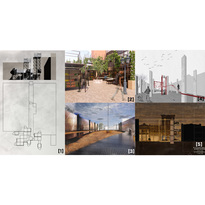At the start of the academic term, my architecture studio had undertaken the challenge of designing pavilions for the Graham Avenue Transit Mall. Starting with a thoughtful intention of repurposing and redefining the uses of abandoned machinery found at the Salvage Supermarket, our next step was to define a flexible intervention that would encourage better engagement with the public.
Though this is no new idea in urban design, our studio dug deep to find out what needs to be better addressed in Winnipeg’s downtown public community to draw the city together.
Anyone who has been downtown would almost immediately observe how many underused corners there are, how there is either an abundance or lack of parking, the highly spanned out areas and how unwelcoming the public spaces are. The current layout of the area is unfavourable from all points of view, whether it be pedestrian, vehicle, bike or bus. The recent closure of many key businesses in the area such as Hudson’s Bay certainly doesn’t help the issue.
If we continue with more of the same Band-Aid type of approaches for downtown that have been tried many times prior — such as developing green spaces that will never be utilized, installing more parking lots, lack of consideration for pedestrian street engagement and accessibility — it will almost certainly continue to degrade.
Our downtown has a long and rich history. It was, at one time, a highly acclaimed district attracting visitors from all around the world. In a constant state of evolution, it would be a colossal shame for this to be the beginning of the end of the area due to negligence of old urban design methods. The downtown district should be able to draw the interests of the entire city and beyond, not take that away with utility-driven infrastructure.
This is why Winnipeggers should pursue design efforts that are communally focused rather than ones that are purely about profit. It’s time we changed the narrative and try new methods that push the envelope toward things that haven’t been done before.
In light of recent news, there appears to be a plan in place to closedown Graham Avenue to all motorized vehicles. This optimistic upswing could provide a great opportunity to allow for new design practice to be incorporated into the area. A positive transformation and redefining of the era could finally come to fruition and Winnipeg needs it.
By applying approaches like tactical urbanism — a concept in urban design promoting citizen-led and low-cost interventions to improve the conditions of communities — the studio and I have tried to transition away from conventional ways urban developers look at and approach our urban fabric in order to change the narrative about downtown Winnipeg’s environment. Our hope is that, by doing so, downtown Winnipeg can become more communal and engaging.
The impetuses behind each students’ project proposal varied and were inspired by the methodology of “found education” which allowed us to explore issues in self-led matters that we were both interested in and strongly felt the need to address.
The resulting projects provide us with a diverse range of conversations about how we can begin to reimagine our urban districts in a more modernized context by reusing and redefining the traditional methods that have been used in the past. They deal with matters such as temporal installations that could be done during the transitional and development phases of a site, street-side markets to incite more interactive living among the community, novelty installations to be discovered by the urban adventurer, reimagined park concepts for leisure and recreation and innovative parking systems for state-of-the-art parking layouts, among many other fantastic proposals.
Although these projects themselves are entirely theoretical and may perhaps not be the most definitive of solutions to our urban issues, they thoughtfully suggest possible routes for change and open a conversation to the complex and nearly unanswerable question regarding the best route to pursue for the future of Winnipeg’s urban district.


